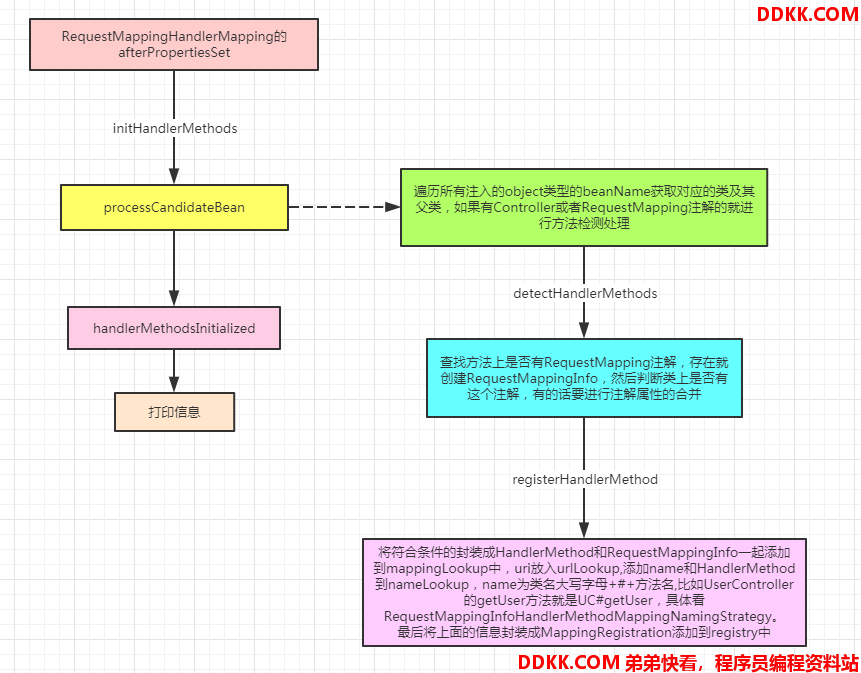简单流程图

RequestMappingHandlerMapping的afterPropertiesSet
我们知道RequestMappingHandlerMapping是根据uri映射来获取相应的方法的,那这个uri是怎么来的呢,我们来看看RequestMappingHandlerMapping被初始化的时候做了什么。在RequestMappingHandlerMapping的父类AbstractHandlerMethodMapping实现了InitializingBean接口,所以在初始化的时候调用afterPropertiesSet方法,这里就是让他做初始化的地方:

AbstractHandlerMethodMapping的initHandlerMethods初始化处理器方法
这里就是获取所有容器里定义的bean名字,不是代理目标的都进行处理。
private static final String SCOPED_TARGET_NAME_PREFIX = "scopedTarget.";
protected void initHandlerMethods() {
for (String beanName : getCandidateBeanNames()) {
if (!beanName.startsWith(SCOPED_TARGET_NAME_PREFIX)) {
//代理目标不行,因为方法可能在代理的时候被重写了
processCandidateBean(beanName);
}
}
handlerMethodsInitialized(getHandlerMethods());
}
getCandidateBeanNames
可见这里是找出Object类型的,也就是所有的注册的bean名字,包括工厂bean。
protected String[] getCandidateBeanNames() {
return (this.detectHandlerMethodsInAncestorContexts ?
BeanFactoryUtils.beanNamesForTypeIncludingAncestors(obtainApplicationContext(), Object.class) :
obtainApplicationContext().getBeanNamesForType(Object.class));
}
processCandidateBean处理
获取类型,如果有Controller或者是RequestMapping注解的就进行方法检测,这里就显示出Controller的用途啦。
protected void processCandidateBean(String beanName) {
Class<?> beanType = null;
try {
beanType = obtainApplicationContext().getType(beanName);
}
catch (Throwable ex) {
...
}
if (beanType != null && isHandler(beanType)) {
detectHandlerMethods(beanName);
}
}
isHandler是否是处理器
只有类上有Controller或者RequestMapping注解的才算是处理器。
@Override
protected boolean isHandler(Class<?> beanType) {
return (AnnotatedElementUtils.hasAnnotation(beanType, Controller.class) ||
AnnotatedElementUtils.hasAnnotation(beanType, RequestMapping.class));
}
detectHandlerMethods检查处理方法
首先会获取处理器类型,然后进行方法的检查,符合要求的就注册到映射注册器中。
protected void detectHandlerMethods(Object handler) {
Class<?> handlerType = (handler instanceof String ?
obtainApplicationContext().getType((String) handler) : handler.getClass());//如果是String就获取他的类型
if (handlerType != null) {
Class<?> userType = ClassUtils.getUserClass(handlerType);//获取用户定义的类型,针对动态代理类型
Map<Method, T> methods = MethodIntrospector.selectMethods(userType,
(MethodIntrospector.MetadataLookup<T>) method -> {
try {
return getMappingForMethod(method, userType);//检测每个方法,获取RequestMappingInfo
}
catch (Throwable ex) {
...
}
});
...
methods.forEach((method, mapping) -> {
//进行映射和处理器绑定
Method invocableMethod = AopUtils.selectInvocableMethod(method, userType);
registerHandlerMethod(handler, invocableMethod, mapping);
});
}
}
MethodIntrospector的selectMethods搜索方法
对类进行方法的搜索,满足条件的封装成RequestMappingInfo和方法一起添加到methodMap中。
public static <T> Map<Method, T> selectMethods(Class<?> targetType, final MetadataLookup<T> metadataLookup) {
final Map<Method, T> methodMap = new LinkedHashMap<>();
Set<Class<?>> handlerTypes = new LinkedHashSet<>();
Class<?> specificHandlerType = null;
if (!Proxy.isProxyClass(targetType)) {
specificHandlerType = ClassUtils.getUserClass(targetType);
handlerTypes.add(specificHandlerType);//获取类型
}
handlerTypes.addAll(ClassUtils.getAllInterfacesForClassAsSet(targetType));//添加所有接口
for (Class<?> currentHandlerType : handlerTypes) {
final Class<?> targetClass = (specificHandlerType != null ? specificHandlerType : currentHandlerType);
//获取所有方法,进行检查,符合条件的放入methodMap中
ReflectionUtils.doWithMethods(currentHandlerType, method -> {
Method specificMethod = ClassUtils.getMostSpecificMethod(method, targetClass);
T result = metadataLookup.inspect(specificMethod);//就是getMappingForMethod
if (result != null) {
Method bridgedMethod = BridgeMethodResolver.findBridgedMethod(specificMethod);
if (bridgedMethod == specificMethod || metadataLookup.inspect(bridgedMethod) == null) {
methodMap.put(specificMethod, result);
}
}
}, ReflectionUtils.USER_DECLARED_METHODS);
}
return methodMap;
}
AbstractHandlerMethodMapping的getMappingForMethod获得方法映射
为创建方法RequestMappingInfo,再为类创建RequestMappingInfo ,进行合并返回。
@Override
@Nullable
protected RequestMappingInfo getMappingForMethod(Method method, Class<?> handlerType) {
RequestMappingInfo info = createRequestMappingInfo(method);
if (info != null) {
//如果方法RequestMappingInfo不为空,就查看类上,如果有的话要合并
RequestMappingInfo typeInfo = createRequestMappingInfo(handlerType);
if (typeInfo != null) {
//如果类上也有RequestMapping,进行合并
info = typeInfo.combine(info);
}
String prefix = getPathPrefix(handlerType);
if (prefix != null) {
info = RequestMappingInfo.paths(prefix).options(this.config).build().combine(info);
}
}
return info;
}
这里就是比较核心的地方,下篇详细讲下。
好了,今天就到这里了,希望对学习理解有帮助,大神看见勿喷,仅为自己的学习理解,能力有限,请多包涵。